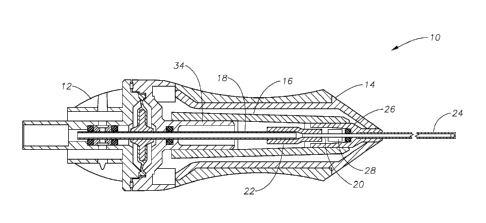Some of the information on this Web page has been provided by external sources. The Government of Canada is not responsible for the accuracy, reliability or currency of the information supplied by external sources. Users wishing to rely upon this information should consult directly with the source of the information. Content provided by external sources is not subject to official languages, privacy and accessibility requirements.
Any discrepancies in the text and image of the Claims and Abstract are due to differing posting times. Text of the Claims and Abstract are posted:
| (12) Patent: | (11) CA 2662294 |
|---|---|
| (54) English Title: | MODULAR DESIGN FOR OPHTHALMIC SURGICAL PROBE |
| (54) French Title: | CONCEPTION MODULAIRE DESTINEE A UNE SONDE CHIRURGICALE OPHTALMIQUE |
| Status: | Granted |
| (51) International Patent Classification (IPC): |
|
|---|---|
| (72) Inventors : |
|
| (73) Owners : |
|
| (71) Applicants : |
|
| (74) Agent: | KIRBY EADES GALE BAKER |
| (74) Associate agent: | |
| (45) Issued: | 2014-05-13 |
| (86) PCT Filing Date: | 2007-07-26 |
| (87) Open to Public Inspection: | 2008-05-08 |
| Examination requested: | 2012-06-13 |
| Availability of licence: | N/A |
| (25) Language of filing: | English |
| Patent Cooperation Treaty (PCT): | Yes |
|---|---|
| (86) PCT Filing Number: | PCT/US2007/074433 |
| (87) International Publication Number: | WO2008/054900 |
| (85) National Entry: | 2009-02-27 |
| (30) Application Priority Data: | ||||||
|---|---|---|---|---|---|---|
|
An ophthalmic surgical probe having a modular drive assembly and a skin that is removable from the drive assembly. This design simplifies probe manufacturing and provides greater manufacturing flexibility.
La présente invention concerne une sonde chirurgicale ophtalmique qui comprend un ensemble d'entraînement modulaire et une enveloppe pouvant se retirer de l'ensemble d'entraînement. Cette conception permet de simplifier la fabrication de la sonde et d'offrir une plus grande souplesse de fabrication.
Note: Claims are shown in the official language in which they were submitted.
Note: Descriptions are shown in the official language in which they were submitted.

For a clearer understanding of the status of the application/patent presented on this page, the site Disclaimer , as well as the definitions for Patent , Administrative Status , Maintenance Fee and Payment History should be consulted.
| Title | Date |
|---|---|
| Forecasted Issue Date | 2014-05-13 |
| (86) PCT Filing Date | 2007-07-26 |
| (87) PCT Publication Date | 2008-05-08 |
| (85) National Entry | 2009-02-27 |
| Examination Requested | 2012-06-13 |
| (45) Issued | 2014-05-13 |
There is no abandonment history.
Last Payment of $624.00 was received on 2024-06-18
Upcoming maintenance fee amounts
| Description | Date | Amount |
|---|---|---|
| Next Payment if standard fee | 2025-07-28 | $624.00 if received in 2024 $651.46 if received in 2025 |
| Next Payment if small entity fee | 2025-07-28 | $253.00 if received in 2024 $264.13 if received in 2025 |
Note : If the full payment has not been received on or before the date indicated, a further fee may be required which may be one of the following
Patent fees are adjusted on the 1st of January every year. The amounts above are the current amounts if received by December 31 of the current year.
Please refer to the CIPO
Patent Fees
web page to see all current fee amounts.
| Fee Type | Anniversary Year | Due Date | Amount Paid | Paid Date |
|---|---|---|---|---|
| Application Fee | $400.00 | 2009-02-27 | ||
| Maintenance Fee - Application - New Act | 2 | 2009-07-27 | $100.00 | 2009-07-07 |
| Maintenance Fee - Application - New Act | 3 | 2010-07-26 | $100.00 | 2010-07-07 |
| Maintenance Fee - Application - New Act | 4 | 2011-07-26 | $100.00 | 2011-07-12 |
| Request for Examination | $800.00 | 2012-06-13 | ||
| Maintenance Fee - Application - New Act | 5 | 2012-07-26 | $200.00 | 2012-07-05 |
| Maintenance Fee - Application - New Act | 6 | 2013-07-26 | $200.00 | 2013-07-09 |
| Final Fee | $300.00 | 2014-02-27 | ||
| Maintenance Fee - Patent - New Act | 7 | 2014-07-28 | $200.00 | 2014-07-09 |
| Maintenance Fee - Patent - New Act | 8 | 2015-07-27 | $200.00 | 2015-07-01 |
| Maintenance Fee - Patent - New Act | 9 | 2016-07-26 | $200.00 | 2016-07-06 |
| Maintenance Fee - Patent - New Act | 10 | 2017-07-26 | $250.00 | 2017-06-28 |
| Maintenance Fee - Patent - New Act | 11 | 2018-07-26 | $250.00 | 2018-07-04 |
| Maintenance Fee - Patent - New Act | 12 | 2019-07-26 | $250.00 | 2019-07-03 |
| Registration of a document - section 124 | 2019-12-18 | $100.00 | 2019-12-18 | |
| Registration of a document - section 124 | 2019-12-18 | $100.00 | 2019-12-18 | |
| Maintenance Fee - Patent - New Act | 13 | 2020-07-27 | $250.00 | 2020-07-01 |
| Maintenance Fee - Patent - New Act | 14 | 2021-07-26 | $255.00 | 2021-06-30 |
| Maintenance Fee - Patent - New Act | 15 | 2022-07-26 | $458.08 | 2022-06-22 |
| Maintenance Fee - Patent - New Act | 16 | 2023-07-26 | $473.65 | 2023-06-21 |
| Maintenance Fee - Patent - New Act | 17 | 2024-07-26 | $624.00 | 2024-06-18 |
Note: Records showing the ownership history in alphabetical order.
| Current Owners on Record |
|---|
| ALCON INC. |
| Past Owners on Record |
|---|
| ALCON, INC. |
| AULD, JACK R. |
| LOPEZ, JOSE LUIS |
| NOVARTIS AG |
| VALENCIA, SALOMON |